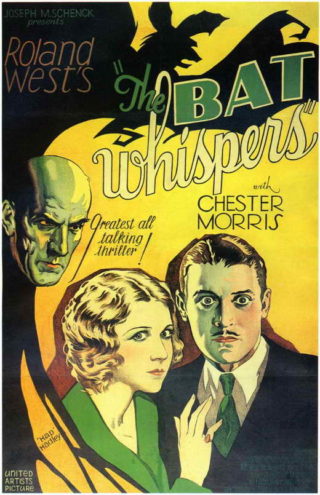 A silly mystery/comedy from 1930 that’s an absolute stunner from a photographic standpoint, with bold expressionistic visuals and wildly innovative camerawork. It was also the alleged inspiration for Batman.
A silly mystery/comedy from 1930 that’s an absolute stunner from a photographic standpoint, with bold expressionistic visuals and wildly innovative camerawork. It was also the alleged inspiration for Batman.
Writer/producer/director Roland West, who thrived during the 1920’s, was known for carefully designed, experimental visuals reminiscent of German Expressionist pictures like THE CABINET OF DR. CALIGARI. Among West’s features were the 1925 Lon Chaney vehicle THE MONSTER and the iconic 1929 gangster drama ALIBI.
THE BAT WHISPERS was West’s second-to-last film. It was a remake of his 1926 silent THE BAT, which was based on a popular play by Avery Hopwood and Mary Roberts Rinehart. THE BAT and THE BAT WHISPERS inspired another much later remake, the 1959 Vincent Price starrer THE BAT, and are widely believed to have provided Bob Kane with inspiration for the character and exploits of Batman.
In keeping with West’s mania for experimentation, THE BAT WHISPERS was lensed and exhibited in a decidedly experimental format: widescreen 65mm (a rare innovation back in 1930). But it was also filmed in standard 35mm, shot by a separate cinematographer and released concurrently with the widescreen version. The Image DVD release contains both versions, and, after viewing them back to back, I’ll have to say the widescreen cut is infinitely preferable, and not just because it was better restored. It’s simply better in every respect.
The Bat is a feared criminal who commits crimes outfitted as a bat. After stealing a priceless necklace from a man’s house one night—literally right under the noses of the man and a cordon of police—the Bat witnesses a bank robbery. He follows the robber to the home of “Banker” Fleming, where the widow Cornelia is staying with her niece Dale and goofball maid Lizzie.
Lizzie believes the house is haunted, and is further convinced upon spotting the Bat creeping around outside. The Bat hurls a rock through a window with a note exhorting Cornelia and her family to vacate the premises, and a voice issues from a behind a painting to reiterate the warning.
The shady Dr. Venrees arrives to inform Cornelia about the bank robbery, and then the glowering Detective Anderson shows up. Cornelia explains to him that she thinks Banker Fleming’s son is trying to frighten her out of the house.
Around this point Dale discovers a hidden room behind a fireplace. There she confronts the Bat—and Banker Fleming, who the Bat shoots and kills. Apparently Fleming and Venrees were in on the bank robbery together, as Detective Anderson deduces. But this leaves the Bat, who’s still at large…
This is very likely the masterpiece of director Roland West, whose filmography contains many recurring themes. The old dark house setting and whodunit storyline directly recall other West opuses like THE GORILLA and THE CAT AND THE CANARY—both, like THE BAT WHISPERS, adapted from stage plays.
Unfortunately, the play in this case is really dumb. It’s packed with moronic comic relief in the form of a retarded maid, and a mystery killer whose identity isn’t exactly difficult to spot (one of the actors is always glowering menacingly into the camera–plus this particular actor is the virtually only man left alive by the time the “surprise” ending arrives).
But West’s visuals have never been more compelling. He favors lengthy pre-steadicam tracking shots, particularly at the beginning, in which the camera drops straight down from a dizzying height onto a (miniature) street stocked with (model) cars.
West’s masterly use of light and shadow was equally unprecedented, particularly in one stunning sequence set within a hidden room. In this scene a woman confronts the Bat, who appears as a giant spread-winged shadow that gradually shrinks down to human size, draws its “wings” into itself and slowly advances toward the terrified damsel. It’s a truly amazing sequence, certainly one of the highlights of the era.
One could argue that such visual flamboyance serves only to detract from the story and characters. I’d counter-argue that there really isn’t a whole lot here in the way of story or characters, so the more distracting the visuals are the better!
Vital Statistics
THE BAT WHISPERS
United Artists
Director: Roland West
Producer: Joseph M. Schenck
Screenplay: Roland West
(Based on a play by Mary Roberts Rinehart, Avery Hopwood)
Cinematography: Ray June (35mm), Robert H. Planck (65mm)
Editing: Hal C. Kern, James Smith
Cast: Chester Morris, Gustav Von Seyffertitz, Una Merkel, Richard Tucker, Wilson Benge, Maude Eburne, William Bakewell, DeWitt Jennings, Sidney D’Albrook, S.E. Jennings, Grayce Hampton
